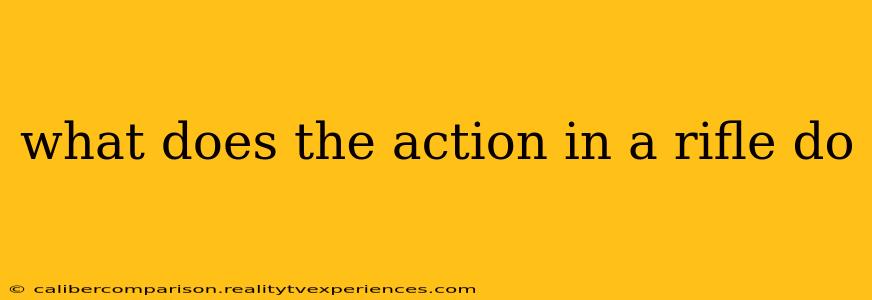Understanding the action of a rifle is crucial for anyone interested in shooting sports, hunting, or simply appreciating firearm mechanics. The action isn't just a pretty part; it's the heart of the rifle, responsible for a complex sequence of events that culminates in a bullet leaving the barrel. This post will break down the function of a rifle action, exploring its different types and the key roles they play.
The Rifle Action: More Than Just a Pretty Face
The rifle action is the mechanism that performs the critical steps of loading, firing, and unloading a cartridge. This involves several key functions:
- Feeding: The action brings a cartridge from the magazine (or manually) into the chamber.
- Chambering: The cartridge is seated firmly into the chamber, aligning it correctly for firing.
- Locking: The action securely locks the bolt or breechblock, ensuring the rifle is safe and the pressure generated during firing is contained within the barrel.
- Firing: This is initiated by the trigger mechanism, which releases the firing pin to strike the primer of the cartridge.
- Unlocking: After firing, the action unlocks, allowing for the extraction and ejection of the spent casing.
- Ejecting: The spent casing is expelled from the rifle.
- Cocking: Many actions require cocking, which primes the firing mechanism. This can be done manually (e.g., via a bolt handle) or automatically (e.g., through the action of the firearm).
Types of Rifle Actions: A Comparative Overview
Different rifle actions are designed for various purposes, impacting factors like accuracy, rate of fire, and overall reliability. Here are some of the most common types:
1. Bolt-Action Rifles
These are known for their simplicity, accuracy, and reliability. The bolt is manually operated, cycling the action through each step—feeding, chambering, locking, unlocking, extracting, and ejecting. They are often preferred for hunting and precision shooting.
2. Lever-Action Rifles
Lever-action rifles use a lever located beneath the receiver to cycle the action. This design allows for relatively fast firing, making them popular for hunting and some competition shooting.
3. Semi-Automatic Rifles
Semi-automatic rifles utilize the energy of the fired cartridge to automatically cycle the action. After firing, the recoil or gas pressure operates a mechanism that ejects the spent casing, chambers a fresh round, and readies the rifle to fire again. They offer a faster rate of fire than bolt-action or lever-action rifles.
4. Pump-Action Rifles
Pump-action rifles use a forend that is pumped forward and backward to cycle the action. Similar to lever-action rifles, they allow for a relatively quick follow-up shot.
5. Revolving Rifles
Though less common than other types, revolving rifles feature a cylinder that rotates to bring cartridges into alignment with the barrel. Each cartridge is fired individually, and the cylinder must be manually rotated after each shot.
Choosing the Right Action for Your Needs
The best rifle action for you depends on your intended use. Consider the following factors:
- Accuracy: Bolt-action rifles generally provide the highest level of accuracy.
- Rate of fire: Semi-automatic rifles offer the fastest rate of fire, while bolt-action rifles are the slowest.
- Reliability: All actions can be reliable, but some are more prone to malfunctions than others. Research is key.
- Ease of use: Bolt-action rifles are relatively simple to learn, while semi-automatic rifles can take more practice to master.
- Maintenance: Regular cleaning and maintenance are essential for all rifle actions.
Understanding the function of a rifle's action is essential for safe and effective operation. By knowing the differences between various actions, you can choose the best tool for your specific needs and appreciate the intricate mechanics behind these powerful firearms. Remember always to practice safe firearm handling and to consult with experienced shooters or professionals before handling any firearm.

